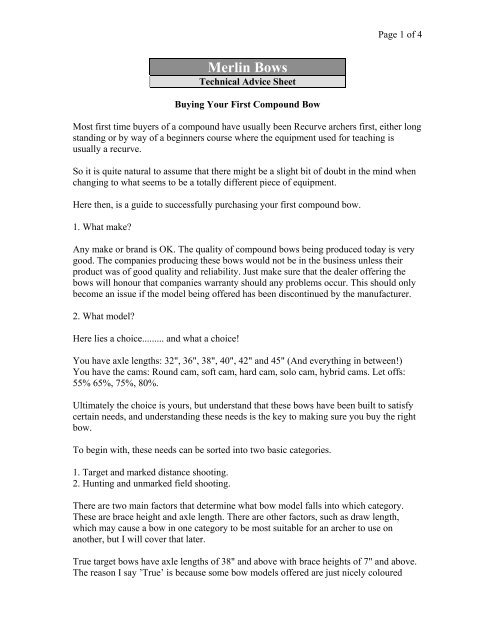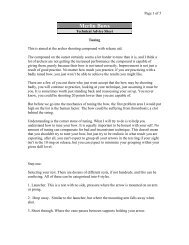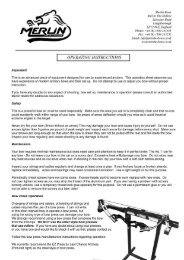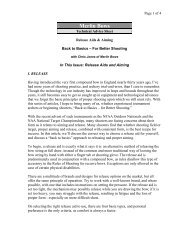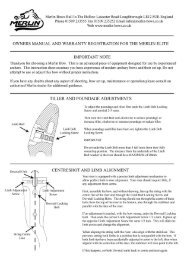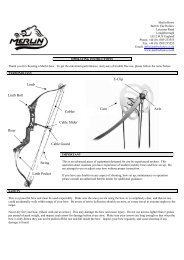Buying Your First Compound Bow - Merlin Archery
Buying Your First Compound Bow - Merlin Archery
Buying Your First Compound Bow - Merlin Archery
Create successful ePaper yourself
Turn your PDF publications into a flip-book with our unique Google optimized e-Paper software.
Page 1 of 4<strong>Merlin</strong> <strong>Bow</strong>sTechnical Advice Sheet<strong>Buying</strong> <strong>Your</strong> <strong>First</strong> <strong>Compound</strong> <strong>Bow</strong>Most first time buyers of a compound have usually been Recurve archers first, either longstanding or by way of a beginners course where the equipment used for teaching isusually a recurve.So it is quite natural to assume that there might be a slight bit of doubt in the mind whenchanging to what seems to be a totally different piece of equipment.Here then, is a guide to successfully purchasing your first compound bow.1. What make?Any make or brand is OK. The quality of compound bows being produced today is verygood. The companies producing these bows would not be in the business unless theirproduct was of good quality and reliability. Just make sure that the dealer offering thebows will honour that companies warranty should any problems occur. This should onlybecome an issue if the model being offered has been discontinued by the manufacturer.2. What model?Here lies a choice......... and what a choice!You have axle lengths: 32", 36", 38", 40", 42" and 45" (And everything in between!)You have the cams: Round cam, soft cam, hard cam, solo cam, hybrid cams. Let offs:55% 65%, 75%, 80%.Ultimately the choice is yours, but understand that these bows have been built to satisfycertain needs, and understanding these needs is the key to making sure you buy the rightbow.To begin with, these needs can be sorted into two basic categories.1. Target and marked distance shooting.2. Hunting and unmarked field shooting.There are two main factors that determine what bow model falls into which category.These are brace height and axle length. There are other factors, such as draw length,which may cause a bow in one category to be most suitable for an archer to use onanother, but I will cover that later.True target bows have axle lengths of 38" and above with brace heights of 7" and above.The reason I say ’True’ is because some bow models offered are just nicely coloured
Page 2 of 4versions of their camouflage counterparts and maybe called the target version purelybecause of its colour and not because its a different model. Checking brace heights andaxle length should establish this.Field and hunting bows can now be found with axle lengths as low as 30" and braceheights as low as 5".It is important to establish which type of archery you will be most serious about. There isno question that lower brace height bows are more difficult to shoot and easier to torqueleft and right, but they do have a speed advantage. With unmarked field shooting, mostpoints are lost through bad distance estimation on the first shot resulting in a high or lowmiss. A faster bow will miss by a smaller amount and may improve your score, as it is thefirst arrow that is the most important. If most points are lost through bad estimation, itmakes sense that a quicker bow will give you an advantage.Marked distance shooting doesn't have the estimation issue but does have small centresand 3-6 shots per end. Consistency becomes the important factor. Larger brace heightscan reduce left and right misses significantly.An expert archer can shoot a fast, low brace height bow successfully for target shooting,just like they can shoot any type of bow successfully, but their technique has to beexcellent to achieve the same results of the more forgiving set up. It would be a mistakefor most archers, particularly first time compound shooters to copy their equipmentwithout having the technique to go with it.Lets OffThe very high 80% let offs were primarily designed for hunting, where the bow may needto be held at full draw for extended periods, or to help with the aiming on heavy drawweight bows. High let off bows can have detrimental effects to the shootability. Itbecomes very easy to distort the bow string and makes the bow easier to torque left andright. My advice is avoid these and stick with a let off of a maximum 70%. (For adetailed explanation of ‘torque’ see previous glade articles)Axle LengthsAs a general rule, the axle length for a target bow is usually 38" and above. Longer lengthbows tend to go hand in and with larger brace heights, and it is these brace heights thatare the most important, although axle length does play a part. It is perfectly acceptableand can be beneficial for short draw length archers, say 27" and below to shoot a shorteraxle length bow. The string angle of a shorter axle length bow at 27" would be the sameas a longer draw archer shooting a longer axle bow, so there would be no detrimentaleffect. In fact, the extra speed gained for that short draw bow would be beneficial.
Page 3 of 4The same goes for long draw length archers. The longer the draw length, the faster thebow, so a person with a 31" draw can shoot a longer axle length bow perfectly well forfield and achieve similar speeds as an average 28" draw on a short axle speed bow.3. What weight?For a first time buyer always purchase the bow with the option to increase the poundage.For ladies by 5# and gents up to 8#. But note that FITA shooting rules prohibit bows over60# draw weight.There are two main reasons for this:i) The poundage or peak weight develops earlier in the draw cycle if you have previouslyshot recurve. <strong>Your</strong> muscles are not accustomed to this change and it will give theimpression of the bow being too heavy. This will be more evident on cams as opposed towheels, but you will soon become accustomed to this.ii) Some designs of wheels when changing draw length (shortening) means the poundageis reduced. When a compound is on its maximum, there is little to be done to increaseweight. This can also limit fine tuning.4. What draw length?By far the single most important and greatly overlooked area on changing to a compoundis the draw length.Of all my overseas visits to different countries, England stands out, in my opinion, asbeing the leaders in inconsistent and wrong draw lengths. I would suggest 50% of thecompound archers in England could improve their scores by reducing their draw length.There is always a misunderstanding that recurve archers relate their draw length to theirarrow length when changing to a compound. Unlike the recurve, the compound can onlybe shot consistently at the specific draw length, set to that specific compound. Therecurve draw length, by the norm, is set to its poundage. Under drawing and overdrawinga recurve affects only the draw weight of the bow.With the compound, on the other hand, the draw weight, or peak weight is not affected bythe draw length when over drawing or under drawing.It is important that you anchor to your correct draw length on a compound bow, you donot draw the bow and then settle into an anchor point. The emphasis must be to thecorrect draw length.<strong>Your</strong> anchor point, when shooting with a release aid, is different than shooting with yourfingers. <strong>Your</strong> anchor point is higher, which shortens your draw length. Because of the
Page 4 of 4release aid, even if your anchor point was to be similar, your arrow length will be shorterby 1/2" - 1".<strong>Compound</strong> bows, like recurves, are sold in draw lengths relating to their arrow lengths.In other words, if you draw a compound bow that is set to a specific draw length, youhave no option but to try and anchor at the position, you instinctively know if it is tooshort, but more often than not, if its too long, you anchor at that position.Hence the saying: anchor to your draw length, do not draw to an anchor point (where thebow wants to be).It is always recommended that you buy from a reputable dealer familiar with the productthey are selling and with the expertise to tune the bow before you leave the shop. Thereare also some good deals to be had from second hand bows, both from archery shops andthe private seller, but be cautious as what may seem a cheap buy at the time can becomeexpensive if the bow needs new cams, or the bow is an end of line model and partsbecome expensive. Check out the availability of parts and cost of replacements prior topurchase. Don’t forget it is a buyers market and there is a great range of compound bowsto choose from, don’t buy the first one you see. Try other makes and models and talk toother compound users.Good luck with your purchase!


